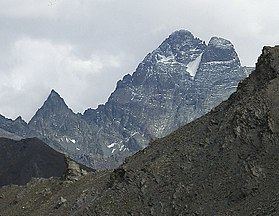Listing Ultra Parent range Cottian Alps Elevation 3,841 m First ascent 30 August 1861 Mountain range Alps, Cottian Alps | Location Piedmont, Italy Easiest route South Face scramble Prominence 2,062 m Province Province of Cuneo | |
 | ||
First ascenders William Mathews, Michel Croz Similar Gran Paradiso, Matterhorn, Mont Blanc, Rocciamelone, Barre des Écrins | ||
Xochilmica o monte viso
Monte Viso or Monviso ([momˈviːzo]; Occitan: Vísol; Piedmontese: Brich Monviso or Viso), is the highest mountain of the Cottian Alps. It is located in Italy close to the French border. Monte Viso is well known for its pyramid-like shape and, because it is higher than all its neighbouring peaks by about 500 m, it can be seen from great distance, including from the Piedmontese plateau, the Langhe, the Theodulpass in the Zermatt ski area and the summits of the Mont Blanc massif. On a very clear day it can be seen from the spires of the Milan Cathedral. It has been suggested that Monte Viso could be one of the mountains which inspired the Paramount logo. In Italy is also known as Il Re di Pietra (The Stone King) because of his prominence within western Italian Alps landscape.
Contents
- Xochilmica o monte viso
- Map of Monte Viso 12030 Oncino Province of Cuneo Italy
- Monte viso versi n compostela aberta
- GeographyEdit
- SOIUSA classificationEdit
- HistoryEdit
- Monte Viso in literatureEdit
- References
Map of Monte Viso, 12030 Oncino, Province of Cuneo, Italy
Monte viso versi n compostela aberta
GeographyEdit
On the northern slopes of Monte Viso are the headwaters of the Po, the longest Italian river, the so-called Pian del Re (2,020 m). The Monviso group is surrounded by the Valle Po, Valle Varaita and, on the French side, the Guil valley. The northern sector of the group, from the Punta Gastaldi to the Col de la Traversette, is located on the French border.
SOIUSA classificationEdit
According to the SOIUSA (International Standardized Mountain Subdivision of the Alps) the mountain can be classified in the following way:
HistoryEdit
Monte Viso is the location of a neolithic jadeite quarry, at an elevation of 2000 to 2400 metres. Its productivity peaked around 5000 BC. The jadeite was used to make cult axes, which are found all over western Europe.
In ancient times the mountain was known as Vesulus.
Monte Viso was climbed for the first time on August 30, 1861 by William Mathews, Frederick Jacomb, Jean-Baptiste Croz and Michel Croz.
Monte Viso in literatureEdit
Monte Viso is mentioned by various authors, Italian and non-, including Dante, Petrarch, and Chaucer. Dante mentions the mountain in a long simile in Canto XVI of the Inferno as the source of the Montone River:
Come quel fiume c'ha proprio cammino
prima dal Monte Viso 'nver' levante,
da la sinistra costa d'Apennino
Chaucer cites the mountain in the prologue to the Clerk's Tale in his Canterbury Tales, in a passage adapted from Petrarch's Latin version of his "Tale of Griselda":
A prohemie, in which discryveth he,
Pemond, and of Saluces the contree,
And speketh of Appenyn, the hilles hye,
That been the boundes of West Lumbardye,
And of Mount Vesulus in special,
Wher as the Poo out of a welle smal,
Taketh his first spryngyng and his cours
That eastward ay encresseth in his cours
To Emele-ward, to Ferare and Venyse;
The which a long thyng were to devyse.
(Geoffrey Chaucer, "The Clerk's Tale," from The Canterbury Tales)
